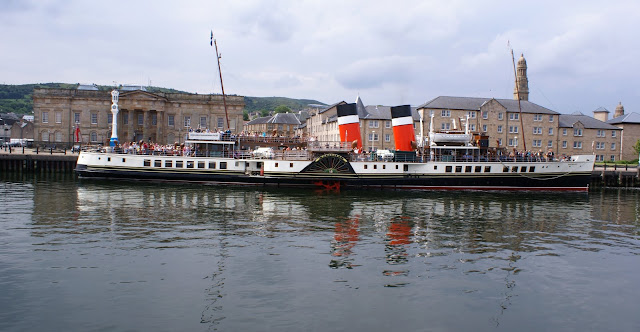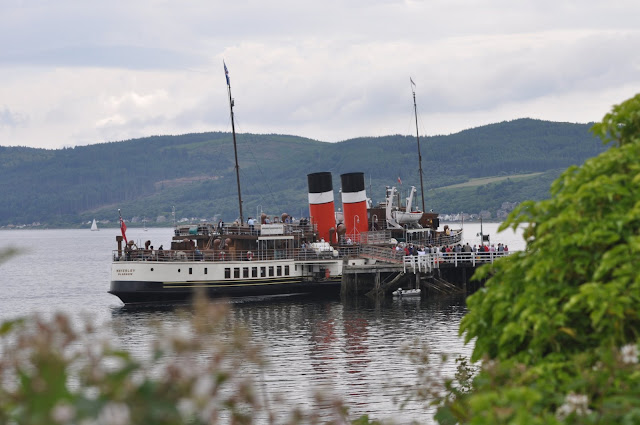Waverley's first Saturday call at Greenock of the 2010 summer season
(Pictures are my own except where stated otherwise, click on picture for full screen view).
Like parts of Waverley's 2100 IHP triple expansion, reciprocating steam engine, the newly repainted Customhouse Quay clock tower was cast in the nearby Rankin & Blackmore's Eagle Foundry in Baker Street, Greenock (click on the image for a bigger view).
Daniel Rankin and Edward Blackmore had started their foundry business in the 1860s. Due to Rankin's pioneering training methods, for his staff, the Eagle Foundry became known locally as 'the Academy' (not, of course, to be confused with the renowned Greenock Academy!). In the 1920s Rankin & Blackmore was taken over by the shipbuilding dynasty, Lithgow's of Port Glasgow, then the largest privately owned shipbuilding group in the world, and remained part of that group until the closure of the Eagle Foundry in 1964.
Daniel Rankin and Edward Blackmore had started their foundry business in the 1860s. Due to Rankin's pioneering training methods, for his staff, the Eagle Foundry became known locally as 'the Academy' (not, of course, to be confused with the renowned Greenock Academy!). In the 1920s Rankin & Blackmore was taken over by the shipbuilding dynasty, Lithgow's of Port Glasgow, then the largest privately owned shipbuilding group in the world, and remained part of that group until the closure of the Eagle Foundry in 1964.
Pictures from MV Cruiser (on private charter)
Below, two more shots from the first Saturday of the paddler's 2010 summer season, these being courtesy of Tom Dunlop. In the first she has canted round the dolphin at the old Berth 1 end of Rothesay pier and is just starting to go astern; this being her normal departure from the pier following the significant rearrangements of the shore side in recent years. Three blasts on the steam whistle (to alert unsuspecting 'wafies' who probably don't know what the signal means anyway!).
and so .......
to Tighnabruaich for the first visit of 2010. First stop: Suzies for some and Tighnabruaich Hotel for others.
Below, on to the Sunday of the first Clyde main season weekend, with some views from the paddler rather than of her. First up, Waverley finds an unusual visitor at the Braehead pontoon - Clyde Marine's motor vessel Rover. Rover had been deputising for the larger mv Cruiser on her new 5-days per week schedule from Glasgow Broomielaw to the Titan Crane at Clydebank (Cruiser having been on a private charter from Greenock on the Saturday).
In fact, at this berth Rover is not far from her birthplace - she was constructed for Clyde Marine Motoring Co. of Greenock in 1964 by the boatbuilder Hugh McLean & Co at their Clyde Boat Yard in Renfrew. The yard was located just upstream of the Clyde Navigation Trusts former workshops and patent slip on the riverside adjacent to the east side of the legendary Pudzeoch (basin). McLean was a prodigous builder of quality small craft, not least being lifeboats for the many prestigious liners built on the river during the halcyon days of Clyde Shipbuilding including those for Cunard's Queen Mary. MacLean's main rivals for this work on Clydeside were Mechans Ltd , which operated from the Scotstoun Ironworks at Balmoral Street on the north side of the river (almost directly opposite the location of this picture). Some estimates put MacLean's output at over 5000 new boats. Rover's Kelvin diesels were supplied by another Glasgow firm Bergius Kelvin whose manufacturing works were in Dobbie's Loan, north of George Square. The firm produced thousands of small diesel engines for small craft, the fishing industry being a major customer. The Dobbie's Loan works are long since closed. Kelvin diesels are now serviced by British Polar Engines Ltd of Helen Street in Govan but no new engines have been produced for many years.
In the picture above, Rover is berthed alongside the preserved, former steam, coaster Kyles, which is now thought to be the oldest Clydebuilt vessel still afloat. In fact Kyles was built on the White Cart River in Paisley. She was Yard No 11 when built by John Fullerton & Co as a cargo coaster for Stuart Manford of Glasgow in 1872. Over the following 112 years she had no less tham 16 different owners on Tyneside, Humberside, the Thames, South Wales and elsewhere on the Bristol Channel. At times in her long and adventurous career she was converted into a sand dredger, salvage vessel and sludge carrier. Her original steam engine, built by William King & Co of Glasgow (a well known builder of marine steam engines in the 19th century), was replaced, in 1953, by a 120 BHP, 4 cylinder diesel engine built by Appingedammer Brons Motoren but that engine dates from 1929 so it had seen significant service before it went into the Kyles. Kyles has been owned by the Scottish Maritime Museum since 1984 (see also http://www.clydesite.co.uk/clydebuilt/viewgal.asp?id=4) and based at their 'Clyde-built' out-station at the Braehead shopping centre in recent years.
Also viewed from Waverley last weekend were two new Coastguard partol vessels being built at BAE Systems Scotstoun Shipyard (formerly Yarrows) for the Government of Trinidad & Tobago. The first vessel, the TTS Scarborough, was launched on 19th November 2009 after which she entered the covered drydock at Scotstoun, the first vessel to go into that Drydock in many years. It was the first drydock to be built at the Elderslie Dockyard when the shipbuilder and repairer John Shearer & Son was forced to vacate their Kelvinhaugh Slipdock in 1907 to make way for the new wharfage that became known as Yorkhill Quay (where the Tall Shp Glenlee is currently berthed, though not for much longer). Scarborough is now alongside the original Yarrow fitting out berth created when the firm moved to the Clyde from Poplar on the Thames in 1906.

TTS Scarborough (CG51) alongside at Scotstoun (viewed from Waverley)
Scarborough's sister ship (seen below on the easternmost of the two covered building berths at Scotstoun) is due to be launched in to the Clyde in the early hours (circa 04:00) of 16th July and, subsequently, she will be named TTS San Fernando. These covered building berths were created by Yarrows after they acquired the adjacent yard of the Blythswood Shipbuilding Company, which had produced its last ship, the Northern Lighthouse Commissioners tender Fingal, in 1964.

Below, the view aft from Waverley slightly further downsstream - the future HMS Defender, fifth of the six new Royal Navy Type 45 destroyers, in the No 3 drydock at Elderslie Dockyard (on the left side of the picture) with HMS Dragon in No 2 drydock (on the right side of the covered No 1 dock) and HMS Diamond lying alongsde Elderslie Wall. TTS Scarborough can be seen in the dstance at the old Yarrow ftting out quay. Diamond has recently completed her sea trials and will soon be handed over to the Royal Navy to join the first two Type 45s, Daring and Dauntless, in the fleet. As can be seen in this view, Defender in Dry Dock No 3 is sitting much higher than Dragon in No 2. This is because the No 3 dock has been specially modified to act as an enclosed, non-tidal wet dock in which the large gas turbine engines can be tested to a much greater degree, and free of tidal restrictions, before the vessels put to sea for the first time. The Type 45 destroyers are the first RN ships ever to adopt turbo-electric transmission, thus eliminating gearboxes, for long one of the least reliable parts of naval machinery installations
The No 3 drydock at Elderslie was built in the 1960s when the firm of Barclay Curle, which had recently closed its famous Clydeholm shipyard further upriver at Whiteinch, expanded its shiprepairing business at the Dockyard. One of the first vessels to enter No 3 dock was the brand new passenger liner Kungsholm which was being built at the John Brown shipyard at Clydebank for the Swedish America line. Kungsholm was the penultimate ocean liner to be built at Clydebank, after her came only the famous Queen Elizabeth 2 (QE2). Although both of these prestige liners were stunning ships in the 1960s and were built to a level of quality that saw them far surpass their original design lives, they proved not to be good contracts for their builders. Brown's lost heavily on both contracts and were driven to the edge of bankruptcy from which they never really recovered.
A press cutting of the beautiful passenger liner Kungsholm leaving her builders yard for sea trials
As is well known QE2 retired to Dubai in 2008 but she is sadly redundant there, a victim so far, of world recession. Kungsholm is still in service, currently named Mona Lisa but her long career will come to an end later this year as she will no longer be able to comply economically with the latest SOLAS (Safety of Life at Sea) regulations. Soon afterwards she is likely to follow many of her predessessors and contemporaries in a full speed, suicidal final run onto the beaches at Alang in India were she will quickly be ripped apart by the oxy-acetylene burner gangs. When Mona Lisa ex Kungsholm has gone, for the first time in well over 150 years there will be no Clyde-built passenger liner sailing anywhere on the world's oceans - indeed, the end of an era.
.jpg)
The beautiful Kungsholm
now (as Mona Lisa) the last surviving operational Clyde-built passenger liner in the world
but not for much longer
(Splendid picture of her by Bob Scott)














































